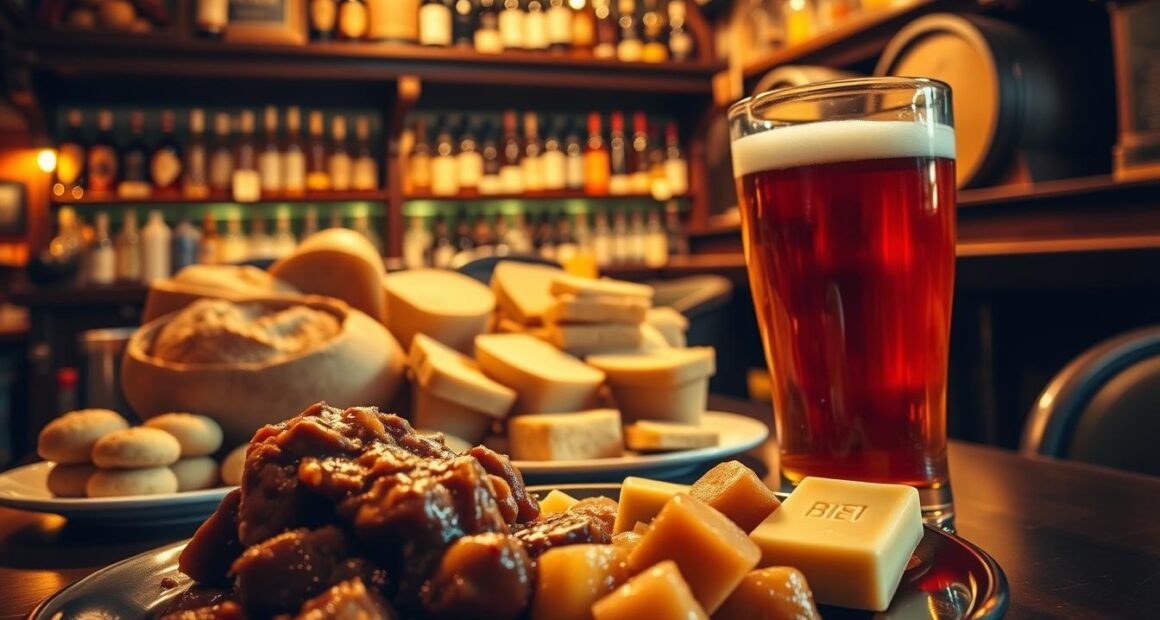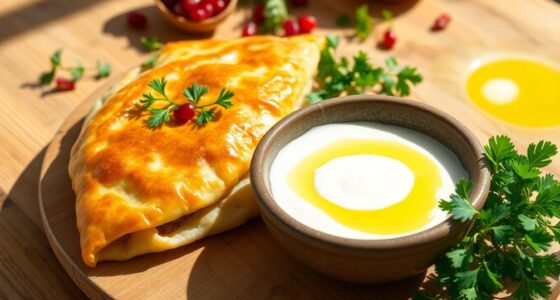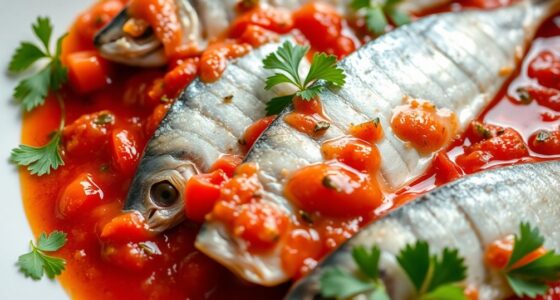Imagine standing in a cozy kitchen, the aroma of simmering broth wafting through the air, transporting you to the heart of Scotland’s vibrant culinary landscape. As you take a spoonful of traditional Scottish food, a wave of warmth envelops you, connecting you to the centuries of history and heritage that have shaped these flavors. Each dish tells a story, steeped in the region’s lush landscapes and age-old traditions. From the rich, hearty warmth of haggis to the delicate flavors of Cullen skink, Scottish cuisine is a delightful exploration of ingredients and techniques that will not only tantalize your taste buds but also inspire your own culinary ventures. Dive into the world of Scottish gastronomy, and you’ll discover a tapestry of unique dishes that celebrate nature’s bounty and the enduring spirit of Scottish hospitality.
Key Takeaways
- Scottish cuisine is rich in history and reflects the culture of the region.
- Traditional dishes like haggis and Cullen skink highlight the use of local ingredients.
- Comforting meals are a focal point in Scottish food, especially during colder months.
- Scottish delicacies often feature hearty flavors that resonate with the nation’s agricultural roots.
- Events like Burns suppers celebrate traditional Scottish food, including iconic dishes and drinks.
- The love for baking, especially shortbread, showcases Scotland’s culinary creativity.
- Exploring Scottish gastronomy opens up new possibilities for enhancing your cooking skills.
Discover the Rich History of Scottish Cuisine
The history of Scottish cuisine is a tapestry woven with the threads of tradition, geography, and evolving culinary practices. The natural bounty of Scotland, influenced by its temperate climate, has shaped a unique food culture that reflects the land’s character. Traditional ingredients, such as oats, barley, and a variety of game and seafood, have been staples in the diets of Scots throughout the ages.
Traditional Ingredients in Scottish Dishes
Scotland’s culinary legacy is rooted in its traditional ingredients. In medieval times, meals often comprised pottages made from local herbs and roots, supplemented by bread and dairy products. As time progressed, the introduction of the potato by Sir Walter Raleigh revolutionized Scottish diets, providing a new source of carbohydrates previously dominated by oats and barley. Today, haggis, neeps, and tatties stand as iconic representations of Scotland’s culinary heritage, often served during celebratory occasions like Burns suppers.
Influence of Geography on Food Choices
The geography of Scotland plays a significant role in its food choices. The rich farming land of the Lowlands contrasts with the rugged Highlands, leading to varied culinary traditions. The coastal regions provide an abundance of seafood, while the popularity of game like Scots grouse is a result of the sporting estates that emerged in the 18th century. The environment shapes not only what is available to eat but also how these ingredients are prepared and enjoyed.
Evolution of Cooking Techniques
Scottish cooking techniques have seen considerable evolution, adapting to both local resources and modern influences. Early methods relied on simple hearth cooking, but as culinary practices progressed, so too did the complexity of dishes. The 19th century brought about the documenting of recipes through individuals like Charlotte, Lady Clark of Tillypronie, marking a pivotal moment in the history of Scottish cuisine. With varying influences from immigrants and the advent of fast food in the 20th century, contemporary Scottish cuisine incorporates diverse elements while honoring its historical roots.

| Period | Key Ingredients | Notable Changes |
|---|---|---|
| Medieval | Pottage, herbs, roots | Basic sustenance meals |
| 16th Century | Potatoes introduced | Shift in staple carbohydrates |
| 18th Century | Game, seafood | Emergence of sporting estates |
| 19th Century | Documented recipes | Preservation of culinary heritage |
| 20th Century | Fast food options | Global influences on food culture |
Must-Try Scottish Dishes for Your Palate
Exploring the culinary landscape of Scotland reveals a treasure trove of must-try Scottish dishes that showcase the country’s rich flavors and traditions. Indulge in these iconic meals that represent the heart of Scottish cuisine, making each bite a delightful experience.
Haggis: The Heart of Scottish Cuisine
Haggis stands as Scotland’s national dish, with roots stretching back to the 1400s. This unique dish combines sheep’s heart, liver, and lungs, mixed with oatmeal, onions, and a blend of spices. Traditionally served with neeps (turnips) and tatties (potatoes), haggis provides a savory and hearty experience that embodies Scottish culture.
Cullen Skink: A Tasty Smoked Haddock Soup
Cullen skink is a beloved traditional soup originating from the town of Cullen. Made primarily with smoked haddock, potatoes, and onions, this creamy dish packs coastal flavor and warmth. Variations may include additional vegetables, enhancing its rich taste and making it a staple in many households across Scotland.
Scotch Eggs: A Savory Snack You’ll Love
For a portable treat, look no further than scotch eggs. These savory snacks consist of hard-boiled eggs enveloped in seasoned sausage meat, all encased in a crispy golden breadcrumb coating. Perfect for picnics or as a quick bite, scotch eggs deliver a satisfying flavor that’s hard to resist.

| Dish | Main Ingredients | Origin |
|---|---|---|
| Haggis | Sheep’s pluck, oatmeal, onions, spices | Scotland |
| Cullen Skink | Smoked haddock, potatoes, onions | Cullen, Scotland |
| Scotch Eggs | Hard-boiled eggs, sausage meat, breadcrumbs | Scotland |
The Role of Whisky in Scottish Cooking
Whisky serves a significant purpose beyond being a beloved spirit. In Scottish cooking, it acts as an essential component that elevates the culinary experience. When you explore whisky in cooking, you’ll find that it not only enhances flavors but also imparts depth to various dishes. From marinades to sauces, whisky finds its way into numerous culinary creations, making it an integral element of Scottish cuisine.
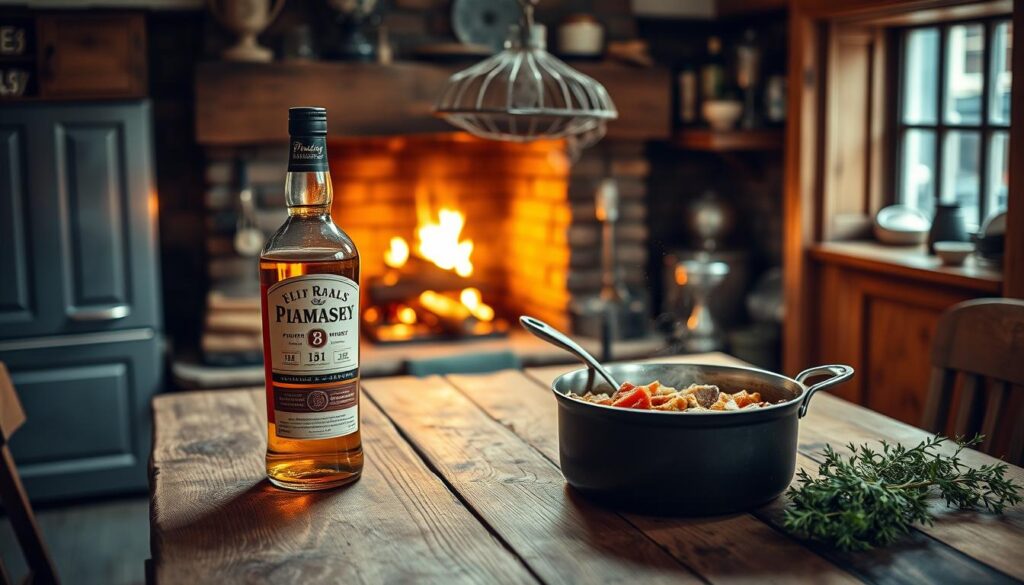
How Whisky Enhances Flavors
Incorporating whisky in cooking can transform ordinary ingredients into extraordinary sensations. The complex notes of whisky add a unique character to your meals. Consider using it for:
- Deglazing pans after sautéing meats, infusing sauces with rich flavors.
- Marinating your favorite cuts, tenderizing while adding a hint of smokiness.
- Enhancing desserts with a splash, as seen in whisky-infused chocolate dishes.
Signature Whisky-Based Recipes
Whisky-based recipes offer a delightful fusion of flavors that impress any palate. Some standout options include:
- Whisky-Glazed Salmon: A perfect balance of sweetness and acidity, this dish pairs beautifully with fresh seasonal vegetables.
- Whisky-Infused BBQ Sauce: Slather this on grilled meats for an unforgettable barbecue experience.
- Chocolate Whisky Cake: A decadent dessert that combines whisky with rich chocolate for a blissful treat.
Pairing Whisky with Your Meal
Understanding the art of pairing whisky with food enhances your dining experience. Here are some tips to consider:
- Peaty Scotches complement hearty dishes like stews and smoked meats.
- Fruity, lighter whiskies pair well with seafood, enhancing the freshness of the dish.
- Sweet varieties work harmoniously with desserts, especially those featuring chocolate or creamy elements.
With so many whisky-based recipes and pairing options, you can create unforgettable meals that highlight the magic of whisky in your culinary journey.
Seasonal Ingredients in Scottish Cuisine
Scottish cuisine truly shines as the seasons change, bringing an array of vibrant fresh produce and flavors. Embracing seasonal ingredients in Scottish cuisine not only reflects tradition but also contributes to health and sustainability. As you dive into a variety of dishes, you’ll discover how spring food, summer delights, and winter warmers play essential roles in culinary experiences throughout the year.
Spring Delights: Fresh Greens and Fish
During spring, Scotland awakens with fresh greens such as asparagus and spinach. This season is also known for its exquisite fish, including salmon and trout, which are a delight served with light sides. Each bite captures the vibrant essence of the warming weather and highlights the importance of seasonal ingredients in Scottish cuisine.
Summer Picks: Berries and Game Meats
Summer unveils a treasure trove of berries, including strawberries and raspberries, which create perfect desserts and breakfast items. Alongside these fruits, game meats like venison come into play, adding rich flavors to barbecues and hearty dishes. The lush Scottish landscape rewards cooks with delightful options throughout this sunny period.
Winter Warmers: Hearty Roots and Stews
As temperatures drop, winter warmers steal the spotlight. Traditional stews made with root vegetables like potatoes, carrots, and turnips become comforting staples during the colder months. These dishes provide both satisfaction and nourishment, showcasing a rich culinary heritage that thrives on the use of local ingredients.
| Season | Ingredients | Dishes |
|---|---|---|
| Spring | Fresh greens, salmon, trout | Salmon salad, green vegetable soup |
| Summer | Berries, game meats | Berry tart, venison stew |
| Winter | Root vegetables | Hearty stews, potato cakes |

Celebrating Festivals with Food in Scotland
Scottish food festivals provide a wonderful platform to experience the rich tapestry of tasting traditions that define the country’s culinary celebrations. Each festival highlights local ingredients and delicacies, inviting visitors to explore a unique aspect of Scotland’s vibrant gastronomy.
Tasting Traditions During Hogmanay
During Hogmanay, Scotland’s New Year celebration, traditional dishes such as haggis take center stage. Families gather to celebrate with food that embodies local culture, often accompanied by a toast of whisky. This remarkable time of year exemplifies how culinary traditions connect generations and strengthen community bonds.
Food Highlights of the Edinburgh Festival
The Edinburgh Festival showcases an array of food options that cater to diverse tastes and preferences. From street food to gourmet dishes, visitors enjoy a delightful sampling of Scotland’s culinary scene. Local chefs take the opportunity to demonstrate their skills, using fresh, seasonal ingredients to create mouthwatering meals that captivate the imagination.
Regional Festivals Celebrating Local Flavors
Scotland’s regional festivals play a crucial role in promoting local flavors. Festivals like the Fife Whisky Festival and the Black Isle Show highlight the unique products of specific areas, blending food and drink in a celebration of Scottish heritage. These events not only connect communities through shared tastes but also attract visitors eager to discover and savor authentic Scottish cuisine.

| Festival | Date | Location |
|---|---|---|
| Scotland’s Specialty Trade Fair | 19th – 21st January 2025 | SECC, Glasgow |
| ScotHot | 26th – 27th March 2025 | SEC, Glasgow |
| Loch Lomond Food & Drink Festival | TBC April 2025 | Loch Lomond |
| Scottish Vegan Festival | TBC April 2025 | Edinburgh |
| Eat And Drink Festival | 23rd – 26th May 2025 | SEC, Glasgow |
Popular Drinks to Complement Scottish Meals
When enjoying Scottish meals, the right beverage can elevate your dining experience. Scotland’s rich culture is reflected not only in its cuisine but also in the wide array of drinks available. From refreshing fizzy beverages to locally brewed beers, pairing drinks with food offers a delightful taste journey.
Irn-Bru: Scotland’s Favorite Soft Drink
Irn-Bru has earned its place as “Scotland’s other national drink.” This vibrant orange soda stands out with its unique and slightly tangy flavor, perfectly refreshing after a hearty meal. The sweetness and carbonation offer a delightful contrast to savory dishes like haggis or Cullen skink. As a go-to choice for many Scots, Irn-Bru has become a staple in homes and restaurants alike.
Craft Beer: A Rising Star in Scottish Breweries
The craft beer scene in Scotland has blossomed over the years, showcasing a diverse range of flavors and styles. Local breweries now produce an impressive selection of ales, stouts, and lagers that you can enjoy alongside traditional fare. Craft beer in Scotland features lower hop content, resulting in smoother tastes that complement everything from fish and chips to game meats. Notable breweries such as Belhaven and Orkney Brewery continue to create beloved local brews that embody the spirit of Scottish drinks.
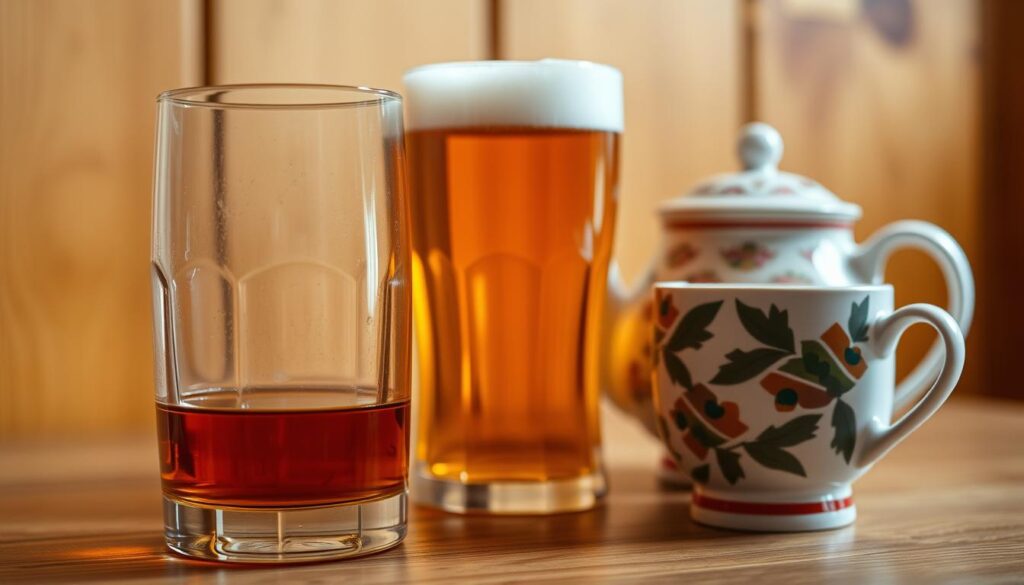
Exploring Traditional Scottish Baking
Traditional Scottish baking is a testament to the country’s rich culinary heritage, showcasing delicious treats that are perfect for any occasion. Two of the most beloved options are shortbread and cranachan. You will find that shortbread, with its delightful crumbly texture and buttery flavor, pairs beautifully with a nice cup of tea. Oatcakes are another popular choice, offering a versatile snack that can be enjoyed on their own or with cheese. For those with a sweet tooth, cranachan stands out as a decadent dessert, featuring a mixture of whipped cream, fresh raspberries, toasted oats, and a splash of whisky.
Shortbread: A Sweet Treat to Enjoy
Shortbread is one of the quintessential examples of traditional Scottish baking. Originating from medieval times, this biscuit is made primarily from butter, sugar, and flour, resulting in its signature crumbly texture. The process of making shortbread involves creaming the butter and sugar, then mixing in the flour to form a dough. After being shaped and baked at a low temperature, the result is a rich and melt-in-your-mouth treat that is perfect for afternoon tea or as a sweet nibble throughout the day.
Oatcakes: A Versatile Snack Option
Oatcakes hold a special place in Scottish baking as a versatile snack option. Made from whole-grain oats, these crisp cakes can be enjoyed in various ways. They serve as a fantastic base for cheeses or can be paired with soups and stews. Their mild flavor allows them to complement both sweet and savory toppings, making them a staple in many households. You can easily whip up a batch of oatcakes using simple ingredients, and their rustic charm will certainly impress your guests.
Cranachan: A Decadent Dessert Recipe
Cranachan is perhaps one of the most delightful desserts hailing from Scotland, encapsulating the essence of traditional Scottish baking. This layered dessert combines whipped cream, fresh raspberries, toasted oatmeal, and a generous drizzle of whisky and honey. It is typically served chilled in individual glasses, creating a visually appealing dish that also offers a burst of flavors. The interplay of creamy, tart, and sweet elements makes cranachan a perfect end to a hearty Scottish meal, embodying the use of Scotland’s natural ingredients.

Regional Variations in Scottish Cuisine
Scottish cuisine showcases a remarkable diversity influenced by geography, tradition, and modern innovation. The regional variations in cooking reveal distinctive preferences, particularly when comparing the highlands vs. lowlands. While the Highlands offer hearty meals rooted in game and robust ingredients, the Lowlands present dishes characterized by grains and dairy products. The rich coastal areas further enhance this culinary tapestry, making seafood specialties a cornerstone of local diets. Urban Scottish cuisine reflects these rich traditions while incorporating global influences for a modern twist.
Highlands vs. Lowlands: Key Differences
In the Highlands, you encounter a rugged landscape reflected in the region’s dishes. Locals often enjoy meals featuring game meats like venison, complemented by root vegetables. The game meat industry plays a crucial role, providing alternatives to traditional beef. Conversely, in the Lowlands, expect hearty dishes featuring grains, dairy, and lighter meats. Popular regional offerings may include the Full Scottish Breakfast laden with bacon, eggs, sausage, and sometimes haggis—each area sharing its unique interpretation.
Coastal Dishes: Seafood Specialties
The coastline of Scotland stretches approximately 6,160 miles, making seafood a dominant aspect of the culinary landscape. Salmon, renowned for its flavor, serves as a staple in many dishes. Iconic regional delicacies such as Cullen Skink—a comforting fish soup made from smoked haddock—originated from the Moray coast. Arbroath Smokies, a delicacy that requires preparation within an 8km radius of Arbroath due to its protected status, showcases the dedication to regional culinary traditions and emphasizes the importance of fresh ingredients.
Urban Influences on Modern Scottish Food
In urban settings like Edinburgh and Glasgow, culinary traditions effortlessly blend with modern influences, resulting in a vibrant food scene. Restaurants often serve innovative takes on classic Scottish dishes, featuring plant-based options and international flavors. This dessert landscape includes beloved choices like shortbread and Scottish tablet, showcasing how regional variations adapt to contemporary tastes while maintaining their cultural significance. Urban Scottish cuisine rejuvenates classic fare, attracting both locals and visitors eager to experience the richness of Scotland’s culinary heritage.

Plant-Based Options in Scottish Cooking
As the culinary landscape in Scotland evolves, there’s an increasing demand for plant-based options that cater to diverse dietary preferences. Traditional dishes often receive vegetarian and vegan makeovers, making it easier for you to enjoy classic flavors without compromising your lifestyle choices. From haggis to hearty soups, the possibilities are endless when you explore the world of vegan Scottish recipes. This section delves into innovative vegetarian options, popular vegan ingredients, and plant-based Scottish recipes that showcase the versatility of Scotland’s natural bounty.
Vegetarian Takes on Traditional Dishes
Many beloved Scottish dishes can easily transform into delicious vegetarian options. For instance, the iconic haggis can be recreated using plant-based ingredients, maintaining its robust flavor and texture. Other traditional items like neeps and tatties or skirlie can be prepared without meat, allowing you to savor authentic ingredients while keeping it meat-free. Adapting these recipes illustrates how traditional Scottish cuisine embraces modern dietary preferences.
Popular Vegan Ingredients in Scotland
Scotland’s rich agricultural landscape supports a plethora of vegan ingredients that are perfect for plant-based cooking. Potatoes reign supreme as a staple, while local grains such as oats, barley, and rye contribute to many hearty dishes. The east coast boasts an abundant supply of wild berries, a delightful addition to both sweet and savory recipes. With pulses and legumes gaining popularity, you’ll find them prevalent in soups and stews, offering a nutritious boost to your meals.
Plant-Based Scottish Recipes to Try
Exploring the world of plant-based Scottish recipes opens the door to a variety of delicious meals. Here are some popular options:
- Vegan Haggis – A hearty dish combining lentils, vegetables, and spices that provides over 50% of your daily protein needs.
- Rumbledethumps – A comforting mixture of mashed potatoes and vegetables, perfect for any occasion.
- Lorne Sausage – A flavorful vegan breakfast item that can be found in many cafes across Scotland.
- Oatcakes – Versatile snacks that pair well with hummus or other plant-based spreads.
These are just a few examples of how you can enjoy traditional flavors through plant-based cooking. Scotland’s culinary scene is embracing change, offering plenty of satisfying vegetarian options for everyone.
| Recipe | Main Ingredients | Nutritional Highlights |
|---|---|---|
| Vegan Haggis | Lentils, oats, onions, spices | 28g Protein, 81g Carbs, 21g Fiber |
| Rumbledethumps | Potatoes, cabbage, onion, plant-based butter | Good source of vitamins C and K |
| Lorne Sausage | Oats, spices, vegetable protein | High in fiber and lower in fat |
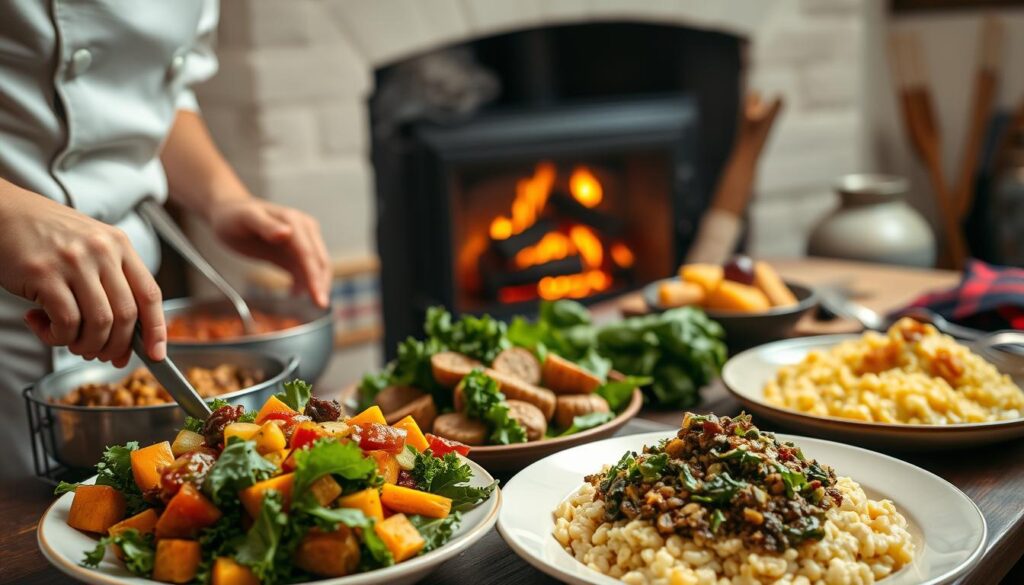
The Importance of Fresh Produce in Scotland
Fresh produce in Scotland plays a vital role in the culinary landscape. With local markets bustling across towns and cities, you can find an impressive array of seasonal fruits and vegetables that truly enhance the flavors of traditional dishes. By sourcing ingredients directly from these markets, you support local farmers while discovering the freshest options available.
Local Markets: Where to Find the Best Ingredients
Local markets are at the heart of Scotland’s commitment to quality. They showcase a diverse selection of fresh produce in Scotland, ranging from vibrant vegetables to succulent fruits. Here are some notable local markets to explore:
- Edinburgh Farmers’ Market: Offers a variety of organic fruits and vegetables every Saturday.
- Glasgow’s Riverside Market: Features local artisans along with fresh produce.
- Stirling Farmers’ Market: A monthly event where local growers display their best goods.
Farm-to-Table Practices in Scotland
The farm-to-table movement is gaining traction within Scotland’s vibrant food culture. This approach creates a direct link between farmers and chefs, ensuring that fresh produce reaches your plate without unnecessary intermediaries. Such practices promote sustainability and support local economies, preserving Scotland’s agricultural heritage while delivering incredible flavors. Recent statistics reveal that the Scottish food and drink sector generates over £15 billion, with substantial contributions from sectors like red meat and dairy. Supporting fresh produce not only enhances your dining experience but also uplifts the community.

| Fresh Produce Sector | Estimated Value (£ million) | Employment (Approx.) |
|---|---|---|
| Red Meat Sector | 850 | 16,000 |
| Cereal Production | 334 | 7,000 |
| Potato & Vegetable Production | 280 | 10,000 |
| Soft Fruit Production | 128 | 6,000 |
| Dairy Farming | N/A | 10,000+ |
By choosing fresh and locally sourced ingredients, you contribute to a well-rounded culinary experience that brings the essence of Scotland to your table.
Exploring Scottish Seafood Delicacies
Scotland’s coastal waters are home to a diverse selection of seafood, offering an exceptional culinary journey. From the famed fresh salmon to delectable shellfish, the range of scottish seafood ensures that every dish showcases the essence of maritime flavors. Emphasizing local ingredients, the preparation of these ingredients preserves their natural taste, making them a highlight of Scottish cuisine.
The Best Places for Fresh Fish and Shellfish
When it comes to enjoying fresh fish dishes, several locations stand out across Scotland. Coastal towns and local fish markets provide some of the best seafood experiences. Notable recommendations include:
- Bay Fish & Chip Shop in Stonehaven – Renowned for having the best fish and chips in the UK, showcasing locally sourced ingredients.
- Loch Fyne Oysters – With locations across the country, these oysters are celebrated for their quality and freshness.
- Clive Ramsay Deli in Bridge of Allan – Offering a delightful assortment of local seafood products and fresh fish selections.
- River House and Mustard Seed in Inverness – Gourmet restaurants that emphasize seasonal and fresh seafood delicacies.
Traditional Preparations of Scottish Seafood
Traditional preparations play a vital role in presenting scottish seafood. Techniques often focus on enhancing the natural flavors while keeping the preparation simple. Popular methods for preparing various seafood include:
- Boiling – A classic method for shellfish like lobster, allowing the rich flavors to shine.
- Grilling – Perfect for fresh fish, imparting a smoky taste that complements the delicate flavors.
- Smoking – Techniques such as cold-smoking for haddock help preserve freshness and add unique taste profiles.
This commitment to fresh and local ingredients results in unforgettable seafood dishes that capture the authentic flavor of Scotland’s rich culinary tradition.
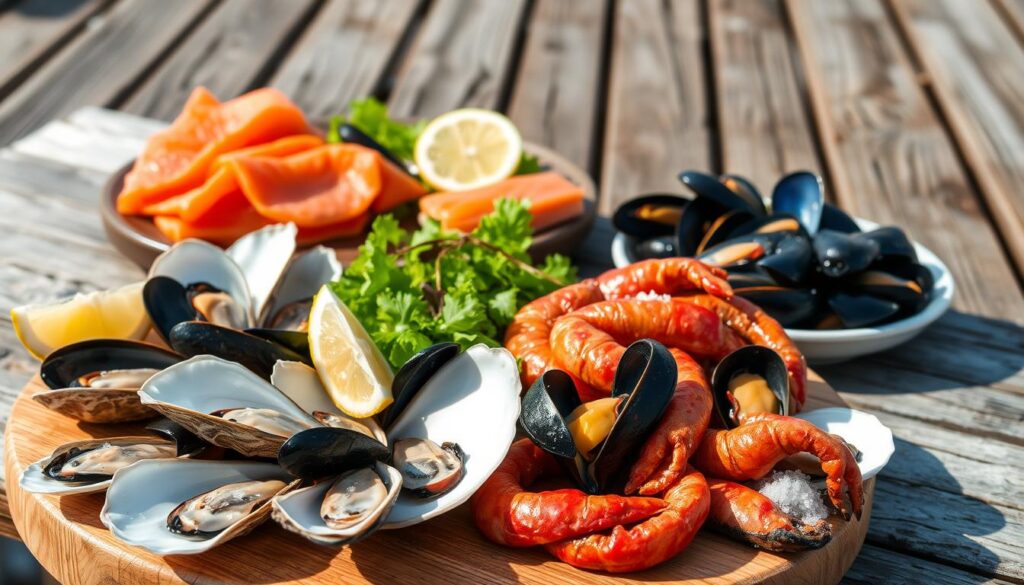
How to Cook Traditional Scottish Meals at Home
Cooking traditional Scottish meals at home opens the door to a world of rich flavors and cherished recipes. Whether you’re preparing dishes like haggis or Cullen Skink, understanding essential cooking techniques is vital. Familiarizing yourself with these methods will enable you to recreate classic dishes that honor Scotland’s culinary heritage.
Essential Cooking Techniques for Beginners
To start your journey in cooking traditional Scottish meals, focus on mastering key cooking techniques. Begin with slow cooking to develop rich flavors in stews, such as a hearty beef stew that requires 3 to 4 hours for optimal tenderness. Baking is another essential skill, especially for preparing delightful shortbread. Traditional shortbread requires a simple combination of butter, sugar, and flour, allowing you to create a treat with minimal ingredients.
Kitchen Tools You’ll Need For Authentic Cooking
Having the right kitchen tools is crucial for efficiently preparing authentic dishes. A heavy-bottomed pot is indispensable for soups, ensuring even heat distribution for consistent results. Invest in a good knife for prepping ingredients, making your cooking process smoother. Additional gadgets like a mixing bowl for dough and a whisk for incorporating air into batters can elevate your traditional cooking experience. Remember, the quality of kitchen tools can significantly impact your ability to create authentic Scottish meals.

The Art of Scottish Food Presentation
When it comes to Scottish cuisine, the way a dish is presented can make all the difference. Fine food presentation transforms a simple meal into an extraordinary culinary experience. Learning effective plating techniques will not only impress your guests but also provide an opportunity to showcase the vibrant flavors and textures typical of Scottish dishes. With a focus on simplicity and authenticity, you can elevate each plate while ensuring the essence of the meal shines through.
Plating Techniques for Impressing Guests
Mastering the art of food presentation requires attention to detail and a few essential techniques. Begin by selecting the right plate; white plates often provide the best backdrop for colorful ingredients. Use negative space creatively to enhance your presentation. Less is more; aim for a focal point using few elements that highlight quality ingredients like Scottish salmon or haggis. Incorporate various heights to create visual interest using twirls, stacks, or layered components.
Serving Suggestions for a Complete Experience
Pairing your dishes with thoughtful serving suggestions will enhance the overall dining experience. For instance, when serving haggis, consider complementing it with seasonal neeps and tatties, garnished with fresh local herbs for a delightful touch. Incorporate textures and colors, using vibrant vegetables and sauces to create contrast. By keeping presentation consistent across all dining formats, you ensure that each meal not only tastes fantastic but looks appealing too.
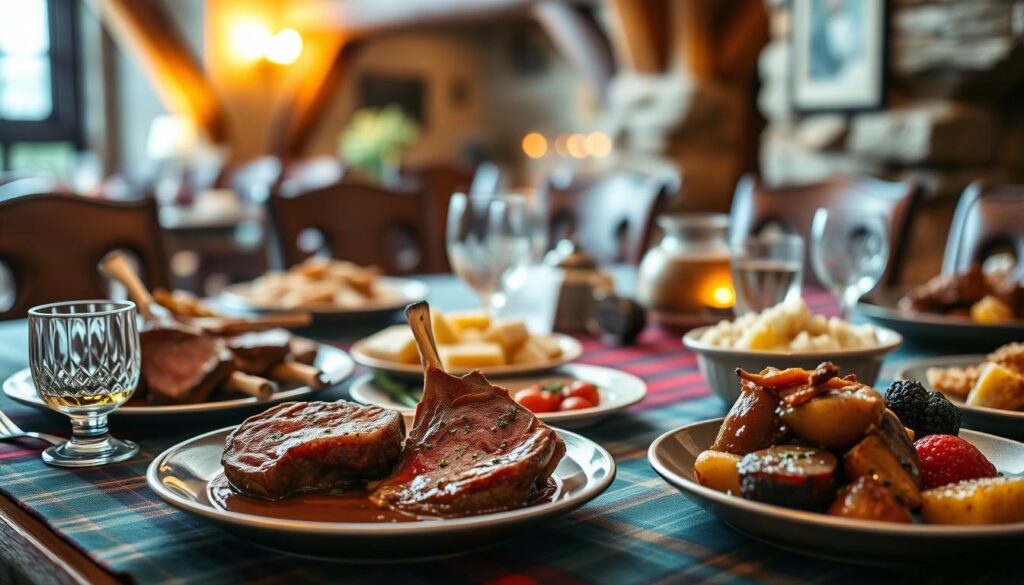
Pairing Scottish Cuisine with Global Flavors
Combining traditional Scottish dishes with global flavors offers a unique culinary experience. You can create exciting fusion dishes by integrating rich Scottish ingredients into international recipes. Consider how the robust flavors of whisky and the freshness of Scottish salmon can enhance classic dishes. This fusion allows you to embark on a culinary journey, discovering the diverse influences that elevate everyday meals.
Fusion Dishes: When Scotland Meets the World
Innovation thrives when you marry Scottish cuisine with global influences. For instance, imagine haggis tacos, where traditional haggis fills soft tortillas, topped with spicy salsa and fresh cilantro. Another idea is to use Japanese miso in a creamy Cullen Skink, providing an umami twist to the beloved smoked haddock soup. You can explore endless possibilities, resulting in delightful fusion dishes that celebrate both Scottish heritage and world flavors.
Popular International Ingredients in Scottish Recipes
Integrating international ingredients into Scottish recipes invites creativity and boldness. Asian spices, such as ginger and lemongrass, can be paired with Aberdeen Angus beef in a stir-fry. Mediterranean herbs like oregano and basil work well with roasted Scottish vegetables, providing depth and excitement. By embracing these global flavors, your dishes will captivate and intrigue those around your dining table.

Final Thoughts on Embracing Scottish Cuisine
Embracing Scottish cuisine opens up a world rich in flavors and tradition. By incorporating Scottish flavors into your cooking, you can recreate classic dishes that resonate with authenticity. Consider sourcing local ingredients or experimenting with modern techniques to add a personalized touch. Whether it’s perfecting the art of making haggis or whipping up a bowl of cock-a-leekie soup, your culinary journey can reflect the heartiness of Scotland’s culinary heritage.
How to Incorporate Scottish Flavors into Your Cooking
One of the joys of Scottish cooking is its communal aspect, making sharing dishes a delightful experience. As you cook with friends, you can delve into the history behind each recipe, transform familiar dishes with a Scottish twist, and deepen your appreciation for these robust flavors. Discovering something new together—like crafting your own vegetarian haggis or indulging in traditional cranachan—can turn a simple dinner into a memorable occasion. This enthusiastic approach to cooking invites everyone to participate in the experience, from prep to plate.
The Joy of Sharing Scottish Dishes with Friends
Bringing together friends and family around the table to enjoy Scottish dishes highlights the warmth and history embedded in each meal. Sharing stories and laughter over a hearty bowl of stovies or a plate of smoked salmon creates a festive atmosphere, reinforcing the connection among diners. The act of gathering will not only allow you to savor delicious flavors but cultivate bonds that celebrate Scottish hospitality and culture, showcasing that meals are more than just food—they are moments of joy and connection.
